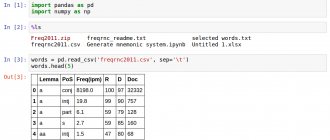- short-term memory - temporary storage where a small amount of information is stored for a short period;
- RAM is a repository for information that is needed only at the moment for some activity;
- long-term memory is a knowledge base for long-term storage of information (several years or even a lifetime).
How it all happens: we try to quickly learn a text or individual facts, and they first end up in short-term memory, and then they may or may not go into long-term memory. The shelf life of information depends on how related it is to our experience - to what we already know.
In addition, there are different types of memory based on the type of perception: visual, auditory, olfactory. Every person periodically uses all these types of memory, but one of them is usually more developed than the others.
Getting to the bottom of things
German psychologist Hermann Ebbinghaus compiled a “forgetting curve” that demonstrates how long new information can be stored in a person’s memory.
Thus, mechanical learning (or cramming) of material without delving into its meaning leads to the fact that in an hour you will remember about 60% of the new information, after 10 hours - 35%, and after 6 days from the depths of your memory you will extract no more than 20 % of material learned.
But meaningful information is stored in the so-called long-term memory, and, therefore, is remembered much longer, especially if it is repeated periodically. In addition, once you understand the essence of the material you are studying, you will remember it 9 times faster.
Remember the information we read
Some people do not have a very good memory, and always wonder how to quickly learn texts by heart. To do this, you don’t need to do anything complicated, just follow the recommendations that will help reduce your learning time significantly.
The surest way to remember something easily is through recollection. This is the name given to the memory function, which helps a person remember information learned in the past.
Reading the text again, a few hours after the first time, will strengthen it in memory.
Having understood the information presented in the work, a person can remember the entire text in a fairly short period of time. Also memorize the piece in parts, it’s easier than learning everything at once. Read thoughtfully, understand the words, understand what you are reading about. Proven fact: what you read before bed is remembered better.
Spaced Repetition
Repetition is the mother of learning. And, indeed, the more often we repeat learned material, the lower the rate of forgetting it.
The method of spaced repetition will help you remember information of any volume.
If you need to quickly learn a verse or prepare in emergency mode for an exam, use the following repetition algorithm:
- the first – 20 minutes after memorization;
- the second – after 6 – 8 hours;
- the third – in a day.
For better assimilation, it is recommended not just to reread the material, but to actively retrieve it from memory, that is, remember it by looking at the source.
If you have a large amount of information to remember that will be useful to you not only for the next day or week, follow this repetition interval:
- first - directly on the day of memorization (repeat all the material);
- the second – after 3 days (repeat only the key points that are highlighted by the author himself or you);
- third - after 6 days (repeat all the information, but try to do it in a different order).
Ideally, it is recommended to repeat the material being studied daily, but devote no more than 15 to 20 minutes to it, so as not to overload the brain.
Another tip:
Try to explain unclear or difficult-to-remember moments to someone. If there is no one willing to listen to a lecture on the theory of probability or the significance of the Renaissance in painting, simply speak out that part of the information that causes the greatest difficulty to your imaginary interlocutor. In the process of such presentation, the brain will automatically select the most simplified formulations.
Advice from professionals: actors give recommendations
Actors memorize long lines all the time. People whose work is directly related to the regular memorization of various materials are more accustomed to navigating the process, and they share practical tips that everyone can apply:
- when reading the material, pay attention to details;
- highlight the main idea of the text;
- try to draw parallels with the knowledge that you already have;
- study the text with desire - working through force will have a dubious result;
- It is most productive to memorize short texts before going to bed;
- Divide large texts into parts, do not try to learn all the material at once;
- associate the text you are studying with music, numbers, colors, etc. - create “reference points”;
- praise yourself for the work you have done, do not hesitate to reward your ego with some pleasant bonus;
- simplify the complex;
- use all senses whenever possible;
- study and read only with a fresh mind;
- create convenient and comfortable working conditions;
- try to get enough sleep, rest is important;
- use pictures (pictograms) to remember text.
We are confident that using these tips you will quickly and easily achieve the desired result.
Go for it, because there are no limits to human capabilities! Find out more about the courses
Edge effect
This phenomenon, the discovery of which also belongs to G. Ebbinghaus, lies in the fact that we quickly remember and most accurately reproduce information located at the beginning and end of the text.
Don't believe me? Let's conduct a short test of attentiveness and memorization. We will voice a number of words that you need to repeat.
Ready?
Chocolate, falling leaves, train, newspaper, radio waves, bed, tower, joy, sleep, construction site, pen, chess.
Which words from the list did you remember first? Chocolate and chess?
What about the words in the middle of the list? How many of them were you able to reproduce - three, five? Well, you have something to strive for.
But how does the edge effect help you remember information? Easily!
Read the text you need to learn. Select the most difficult parts and start learning them first or last.
Of course, we cannot say that the edge effect always works 100%, but in most cases it does work.
How neural connections are formed
We are born with many neurons, but few connections between them. Neural connections are formed as we interact with the world around us, making us who we are.
Sometimes there is a desire or need to modify already formed connections. It seems that since once in childhood they were formed without much effort, then now it will be as easy as shelling pears. But if an adult does not constantly work on creating them, then it will be more difficult to perceive and remember new data. New nerve chains are not as strong as old ones, and they break down faster.
Source: giphy.com
Feynman method
Richard Feynman, a theoretical physicist and Nobel laureate, formulated a learning algorithm that allows you to study any topic faster and more deeply.
This simple method is based on explaining new and complex material in clear and simple language.
, making it easier to memorize.
The essence of the technique can be reduced to three simple points:
- We write down everything we know about the topic that needs to be learned.
- We identify “gaps” in knowledge and fill them, and new information should be written down in the simplest possible language, not containing complex terms and long sentences.
- We combine all the available information into one simple and interesting story, which must be presented on a piece of paper in such a way that an eight-year-old child can understand it. And then we retell it.
Use comparisons, visualization (accompany notes with diagrams, graphs, drawings). Remember that we perceive 90% of information through vision.
You can record your story on a voice recorder or any other gadget, which will help you identify “blank spots” during the retelling that need to be worked out again.
You may argue that this method has been used for a long time without Feynman, and you will be absolutely right. Everything new is long forgotten old. Feynman systematized, structured and expanded this simple but effective method of memorization.
Using the Feynman method, you can make an interesting and fascinating story out of the most boring and uninteresting material, which both adults and children will understand and remember.
Reading quickly improves memory
Very few people know how to quickly learn a text by heart. First of all, you need to master the technique of speed reading; this is what will help you identify the most important information from a large text or from an entire book in a short time.
Reading may be different:
- leisurely - it is classified as reading works of fiction (novels, detective stories, etc.);
- concentrated - required to study very important information;
- fast reading - with its help it is easy to highlight the main thing from a large text;
- fluent – the essence of the information is remembered without details.
Using the speed reading technique, a person can easily highlight the main information in the text and not waste his time on unnecessary water in it.
To master the technique of speed reading, it is recommended to initially read the table of contents of the book, this will help to form a general impression of it. Then read the introduction, chapters, pay attention to the highlighted information in the text, what the author emphasizes.
Train your speed of reading words per minute, each time take a new page from the book for the exercise.
Massive memorization method
This method is familiar to us from school. It is as simple, understandable and bears fruit as possible.
Take notes on the material you need to learn.
Write out your main points by hand, paraphrase them in clearer language, highlight important information with a contrasting color, use lists and numbering. This will help not only to delve into the material and remember it for a long time, but also, if necessary, to quickly refresh your memory of the main points.
But that’s not all, because we are talking about massive memorization, and, therefore, we use all the senses. Therefore, we not only rewrite and review the material, but also speak and listen to it.
Fool the magic number 7±2
The famous American psychologist George Miller found that short-term human memory cannot remember and repeat more than 7 ± 2 elements. The mode of constant information overload reduces this number to 5 ± 2.
Nevertheless, there is a simple way to deceive the laws of short-term memory: using the method of stories, which involves logical linking of disparate memorization objects into one chain. You may end up with a funny, incredible and completely impossible story in real life. The main thing is that with its help you can remember more than 15 elements at a time.
According to the director's plan, in the next scene you should swim in a pool filled to the brim with semolina porridge. Yes, just imagine this madness in bright colors. Feel the semolina sticking to your skin. How hard it is to swim in this warm liquid, although the porridge is not too thick. How the air smells of milk, butter and childhood.
Interference
Similar memories get mixed up - this is the essence of interference. New information, superimposed on similar old information, complicates the memorization process.
Here's a simple example:
To unlock your gadget, you have been using the same pin code (picture, graphic symbol) for years. Over time, you get pretty tired of it, and you decide to change it. At first, every time you enter a new code or graphic symbol, the memory will automatically produce the old version of the code, so you will need some effort to remember the new combination. Several days or weeks will pass, and you will automatically remember the new code, while you will gradually forget the old one.
To reduce the negative impact of interference, it is recommended to study similar information at different time intervals.
If you do not have this opportunity, break the material into blocks and organize the memorization process in such a way that the parts of the text studied one after another are as dissimilar as possible.
And one more tip:
If you need to master a large amount of information, do not just break it up into blocks, but also study it in different rooms (if you wish, you can do this on the street or in transport). Changing the environment when memorizing individual blocks will help avoid mixing information.
Tip 3: How to learn Roman numerals with your child
Our children use Arabic numbers every day and know them well. But sometimes, while reading a book or looking at a watch dial, they come across some incomprehensible icons - Roman numerals. It is difficult to read what is written without knowing it, and a single number written in Roman numerals can be seriously confusing.
Tell your son or daughter about Roman numerals, open up a whole interesting world for them and give them self-confidence.
You may be interested in: How to write a funny story
How to tell about a new way to count numbers
Play a game with your child. Tell him that once upon a time there lived the ancient Romans who came up with a very interesting way to count what they had. And they had sheep and goats, they grew and sold apples and pears, potters made beautiful dishes, and weavers made rolls of fabric. And in order to sell and buy all this, numbers were needed. These are the numbers that were called Roman.
And at first they counted... correctly, on their fingers. This is how the first number appeared - I. Show your child how to get the numbers 2 and 3, it is best to use counting sticks for this. Then show the number V by combining it from two sticks and ask what it looks like (like a palm). Now make the number X, first using sticks, and then showing two palms together, folding them like an hourglass.
Now tell him how the Romans composed 4 (5-1, stick placed on the left), and 6 (5+1, stick on the right). Happened? Now let the child think about how to make the number 11. What about 9? What about 12?
Here are some fun activities to help you consolidate your new knowledge:
1) Find several clocks in the house and determine what numerals they have, Roman or Arabic. If you don't have a clock with Roman numerals in your home, photographs or pictures will do.
2) If you are already reading history books, try to find any number written in Roman numerals (this is how a century is usually written) and read it. And if you don’t have history books at hand, look in children’s encyclopedias.
3) Think about how you can show the number V with your body. And I? And X?
4) Draw a tree with your child and try to find Roman numerals among its branches. Surely you will find the numbers V and I, and maybe something else.
5) Play a guessing game - take turns telling each other numbers up to ten and laying them out with counting sticks.
6) But the task is more difficult. Lay out an example with counting sticks and ask them to find the mistake.
VI –I = IV
III + I – III
IX – I = IIX
These games will bring your child pleasure and help him learn numbers that are new to him.
Palace of Memory (Palace of the Mind)
Mnemonics with such a poetic name are based on the construction of an associative series. It allows you not only to distribute information into memory cells in small portions, but also to connect them together with logical associative threads.
Let’s say right away that this is a rather difficult technique for a beginner, but having mastered it, you will be able not only to quickly memorize information, but also to use only that part of it that is needed here and now, thereby not overloading the brain.
How to create lasting associative connections between familiar information and new information:
- Select a place to “build” the castle.
At first, it is better to use your apartment as familiar information, where everything is familiar to you down to the smallest detail. Over time, when you master the technique, you can “build” real palaces in your imagination. - Attach new images to interior items
, which are commonly called “strong points.” It is important that the strong points are highlighted sequentially: clockwise or counterclockwise. This will help to build logically understandable connections and not get confused in locations. In addition, the more emotional and extraordinary the associations are, the faster they will be remembered. - We turn on our imagination and come up with a short story, taking into account strong points and associations.
Let's look at how the method works using an example.
Let’s make a shopping list that includes 10 products (let’s not be original and take the basic set):
- bagel;
- sugar;
- milk;
- bananas;
- potato;
- chicken fillet;
- eggs;
- green onions;
- cookie;
- coffee.
Let’s imagine our “memory palace”, or rather the kitchen, since we are going to the grocery store. Let us highlight the strongholds located clockwise in the following sequence:
- door;
- dinner table;
- bowl of fruit on the dining table;
- chair;
- windowsill;
- fridge;
- table top;
- bread box;
- sink for washing dishes;
- plate.
Let's start creating associative links:
- We want to open the door to enter the kitchen, but there are three bagels hanging on the doorknob (you can change the number as needed).
- We approach the dining table, which is covered with sugar.
- Milk flows from a fruit bowl.
- There is a banana peel on the chair.
- Potatoes grow on the windowsill, just like in garden beds.
- We open the refrigerator, and there a surprise awaits us in the form of a live chicken.
- We see broken eggs on the countertop.
- Green onion feathers stick out from the bread bin.
- Instead of dishes, there are kilos of cookies in the sink.
- And on the stove, despite all this chaos, a cup of aromatic black coffee is brewing.
It may seem that all this is stupid, ridiculous and requires a lot of time and effort (it’s easier to write a list of products on a piece of paper), but in fact, after a few trainings, you will be able to remember lists of 50 items. The main thing is not to change the situation in your location and the sequence of its passage.
Test the effectiveness of the technique for yourself and share your results in the comments.
Tip 2: Charging the battery: how to cope with the task
You may be interested in: How to find a book without a title
Surely, one of the readers of this article has encountered a situation where you urgently need to go somewhere, literally for 5 minutes, but when you approach the car, you realize that the headlights have been on all night and the battery charge may not be enough for the trip. To prevent this? You should charge the battery more often.
Using mnemonics
In general, associative connections, which are the basis of mnemonics, are a powerful aid in memorizing information:
- Use mnemonic phrases:
from childhood, we all remember the colors of the rainbow and their location thanks to the expression “Every hunter wants to know where the pheasant sits.” - Rhyme information
that is difficult for you to remember. - Humming
it helps to master new material (remember how in childhood we learned poetry in a chant manner). Auditory associations helped many of us learn the English alphabet with the famous ABC song. And in general: if you remember information more easily by ear, just record it on a voice recorder or any other gadget. In addition, it is very convenient, because you can repeat the material anytime and anywhere – in transport or while jogging. - Visualize:
draw diagrams, diagrams, graphs, create whole pictures, even if only you understand them, not only on paper, but also in your imagination.
Online school EnglishDom.com - we inspire you to learn English through technology and human care
Only for Habr readers, the first lesson with a teacher via Skype is free
! And when you purchase a lesson, you will receive up to 3 lessons as a gift!
Get a whole month of premium subscription to the ED Words app as a gift
.
Enter promo code ebbinghaus
on this page or directly in the ED Words app. The promotional code is valid until 04/14/2021.
Our products:
- Learn English words in the ED Words mobile app
- Learn English from A to Z in the ED Courses mobile app
- Install the extension for Google Chrome, translate English words on the Internet and add them to study in the Ed Words application
- Learn English in a playful way in the online simulator
- Strengthen your speaking skills and find friends in conversation clubs
- Watch video life hacks about English on the EnglishDom YouTube channel










